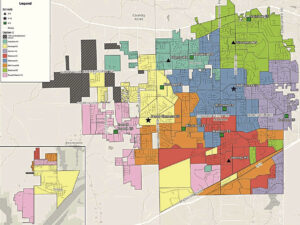Area braces for extreme cold and travel complications; officials advise being prepared
Temperatures that a forecaster expects to create “life-threatening cold” conditions locally Thursday night could complicate holiday travel, and emergency officials advise residents to be prepared.
Thermometer readings could reach lows not experienced in north Alabama since 2018, according to the National Weather Service in Huntsville.
An arctic cold front is expected to send temperatures down to single digits or low teens, with windchill making conditions feel as cold as minus 10 degrees, said weather service forecaster Katie Magee.
She said there is a very low chance of snow.
“I think we’ll see a couple of flurries, but it’s not like we’re going to have several inches,” she said.
Temperature are expected to hover in the mid-50s through the daytime Thursday, then drop below 10 degrees at night, with windchill making the air feel like it’s 0 to minus 10 degrees. On Friday, the high is expected to be around 17.
On Christmas Eve and Christmas Day, low temperatures will be around 10 to 15 degrees, with windchill making it feel like 0 to minus 15.
Traveling tips
Rain expected in the middle of this week could lead to road hazards. Magee said one of the greatest dangers if roads are wet when temperatures begin to drop is black ice could form. It’s a thin coating of ice on a roadway that is transparent and appears to be the same color as the road.
“If you see any wet areas on the road, be careful. Don’t slam on your brakes. Try and coast until you regain traction,” Magee said.
The U.S. Department of Agriculture said black ice often forms on bridges and places where sunshine does not often reach, like roadways shaded by trees and beneath overpasses.
The USDA says overcorrecting once hitting ice can cause a vehicle to spin out. Keep your steering wheel straight and avoid hitting your brakes until you pass over the ice. If you feel the back of your vehicle sliding, make a very gentle turn in the same direction.
Do not speed, and most importantly, do not tailgate, the USDA said. Check tire treads and never use cruise control in potentially icy conditions.
Magee said Dec. 22 and 23 are the busiest days for travel, so the cold snap on Thursday night will create travel complications. She said limiting travel is ideal.
If you do travel, she said, closely monitor the weather to keep track of conditions, but also have a winter emergency kit in your vehicle because it could be a lifesaver.
“If the worst does happen, you’re prepared,” she said.
Emergency supplies
A good winter supply kit includes extra chargers for devices, a first aid kit, flares, a flashlight, water and snacks, warm clothes and blankets.
She said keeping sand or cat litter to get your vehicle unstuck from slippery conditions is also a good idea. Jumper cables also can be helpful.
Keep your gas tank more than half full. In case you’re stranded, you can intermittently keep the car running to keep yourself warm. Also, let people know you’re traveling and when you’re expected to arrive so people can locate you in case something happens.
She also stressed the importance of dressing in layers — even for tasks as simple as stepping out to get mail, as you could get locked out or another emergency could happen.
She said in-house preparation for freezing temperatures is just as important.
Leave faucets dripping to avoid pipes bursting in freezing weather. Make accommodations for pets, and preferably bring them inside the house.
She also said heating can cause many problems in freezing temperatures.
“Heating is one of the most common causes of house fires,” she said.
She said to make sure heaters are always attended and in appropriate areas — never near anything flammable. Never burn anything in a closed area that could cause fumes.

















